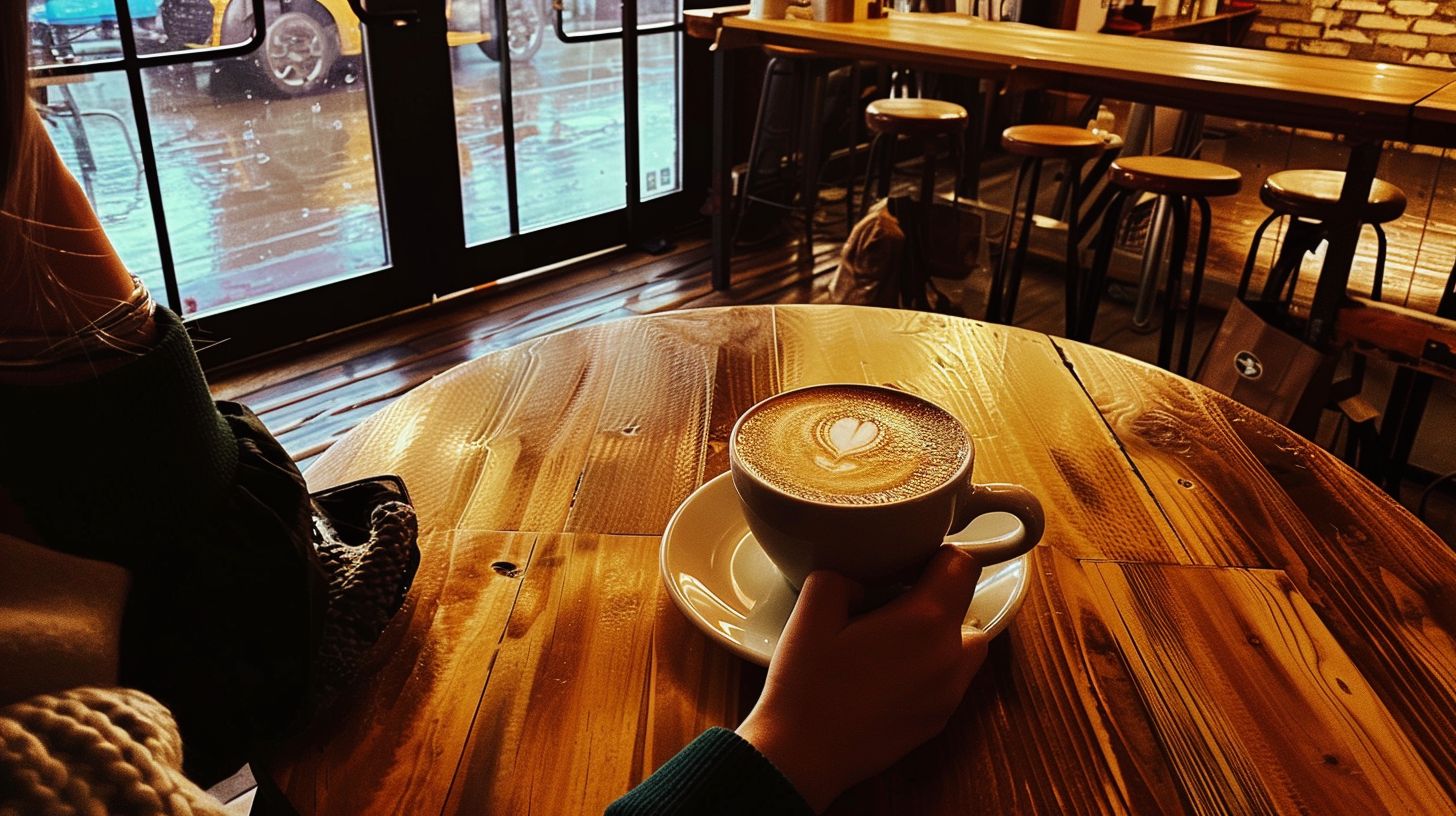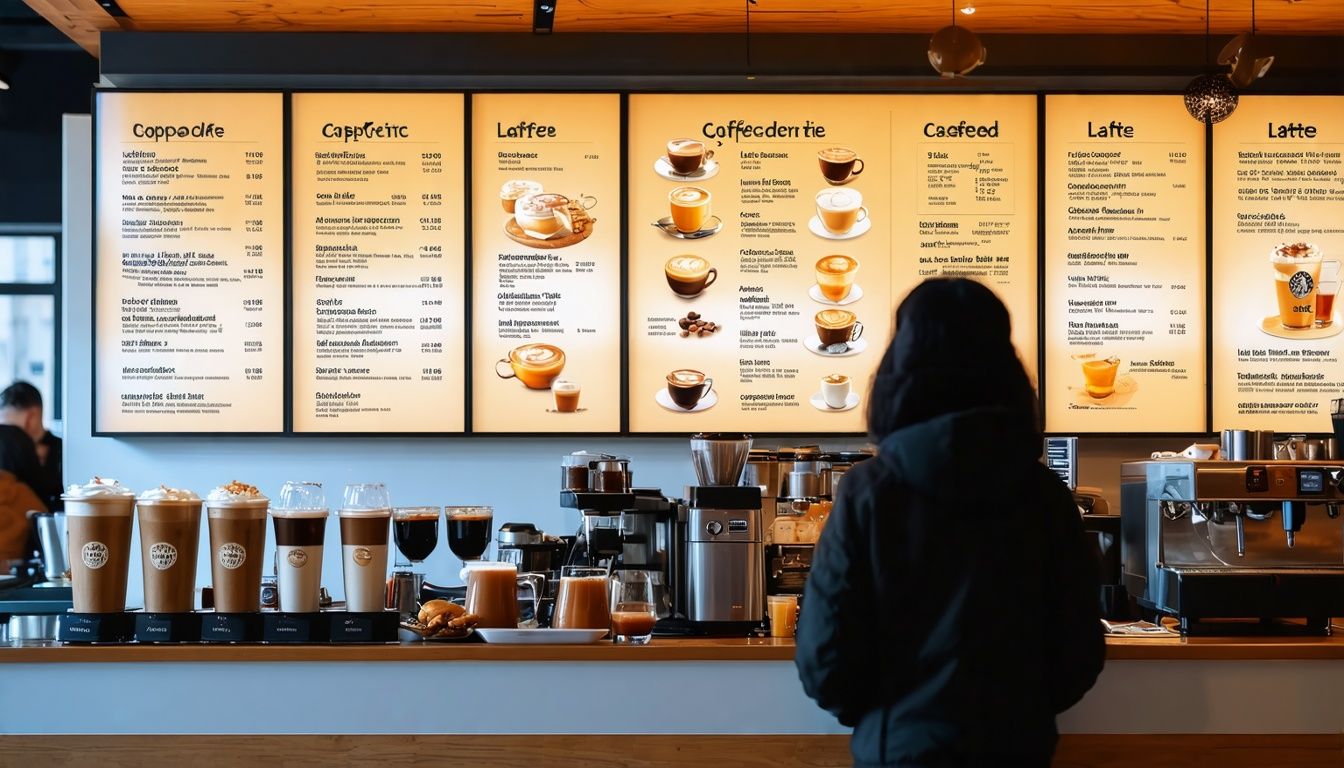Cappuccino Vs Latte – Difference Between Latte And A Cappuccino
Ever stood in a coffee shop, baffled by the menu? Many coffee lovers struggle to tell the difference between a latte and a cappuccino. These two popular drinks often cause confusion, leaving you unsure which to order.
Did you know that the main difference lies in the milk texture? A latte has thinner steamed milk, while a cappuccino boasts full froth with a heavier mouthfeel. This guide will clear up the confusion, helping you choose the perfect brew.
Ready to become a coffee connoisseur?
What is a Latte?
Lattes are a popular coffee drink, born in America and gaining fame in 1980s Seattle. You’ll find them made with one or two espresso shots, topped with steamed milk and a thin layer of froth.
The name “latte” means milk in Italian, reflecting its milky nature. Compared to cappuccinos, lattes have more steamed milk, giving them a smoother texture.
You can enjoy lattes hot or cold. The preparation differs only in how the milk is frothed. Iced lattes are perfect for summer, while hot lattes warm you up on chilly days. Many coffee shops offer flavoured syrups to customise your latte, making it a versatile choice for coffee lovers.
What is a Cappuccino?

Cappuccino, an Italian coffee classic, combines equal parts espresso, steamed milk, and frothed milk. This creamy beverage, served in a 150-180ml cup, boasts a distinct layered texture.
Its name, inspired by Capuchin monks’ habits, hints at its rich history.
Traditional cappuccinos often feature a dusting of cocoa powder, while modern versions use microfoam for a velvety finish. The drink’s 1:1:1 ratio of espresso, steamed milk, and foam creates a balanced flavour profile, appealing to coffee lovers seeking a strong yet smooth cuppa.
Comparing Ingredients and Preparation Techniques for Lattes and Cappuccinos
Lattes and cappuccinos start with the same base: espresso. A latte uses more steamed milk and less foam, while a cappuccino balances equal parts espresso, steamed milk, and foam. Your barista creates a latte by pouring steamed milk over espresso, topped with a thin layer of milk foam.
For a cappuccino, they add equal amounts of steamed milk and thick, airy foam to the espresso.
The milk-to-espresso ratio differs significantly between these drinks. A latte contains more steamed milk, resulting in a creamier texture and milder coffee flavour. Cappuccinos offer a stronger espresso taste due to less milk and more foam.
The foam in a cappuccino acts as an insulator, keeping the drink warmer for longer compared to a latte.
Exploring the Taste and Texture of Cappuccinos and Lattes
Cappuccinos pack a stronger punch than lattes. The majority of milk in a cappuccino sits on top as foam, intensifying the espresso flavour. Lattes, with more steamed milk, taste sweeter due to the milk’s natural sugars drawn out during steaming.
The milk-to-espresso ratio in lattes creates a milder, creamier experience.
Texture-wise, cappuccinos offer a frothier mouthfeel with their thick layer of foam. Lattes provide a smoother, silkier texture thanks to their microfoam. The ratio of milk to foam in each drink shapes its unique profile – cappuccinos are bolder and airier, while lattes are velvety and more mellow.
In-Depth Insights on Lattes and Cappuccinos
Lattes and cappuccinos pack more than just flavour. You’ll find surprising differences in their caffeine levels, calorie counts, and global popularity.
Caffeine Content in Lattes vs. Cappuccinos

Lattes and cappuccinos pack the same caffeine punch. Both drinks contain identical amounts of espresso, resulting in equal caffeine content.
| Drink | Caffeine Content |
|---|---|
| 475ml Latte | 173 mg |
| 475ml Cappuccino | 173 mg |
| Macchiato | 85 mg |
You’ll find no difference in the energy boost between these two popular coffee drinks. Macchiatos offer a lighter option with less than half the caffeine. Choose your beverage based on taste preference, not caffeine content.
Popularity Trends: Latte vs. Cappuccino
Popularity trends for lattes and cappuccinos have shifted over time, reflecting changing consumer preferences and cultural influences.
| Trend | Latte | Cappuccino |
|---|---|---|
| Historical Origin | Popularised in Vienna, not Italy | “Kapuziner Kaffee” recipe from 1790 in Vienna |
| Global Popularity | Higher, especially in English-speaking countries | Strong following in Europe |
| Customisation Options | More varied (flavour syrups, alternative milks) | Traditional, fewer variations |
| Seasonal Preference | Year-round favourite | More popular in cooler months |
You’ll find lattes dominating coffee shop menus worldwide. Their versatility and milder taste appeal to a broader audience. Cappuccinos maintain a loyal following, especially among traditional coffee lovers. Regional preferences play a significant role in these trends. The flat white, a close relative, gained popularity in the late 80s in Australia and New Zealand.
Calorie Comparison: Which is Lighter?
Cappuccinos contain fewer calories than lattes due to their higher foam-to-milk ratio. Here’s a quick comparison:
| Drink (350ml) | Calories |
|---|---|
| Cappuccino (whole milk) | 130 |
| Latte (whole milk) | 210 |
For a larger 475ml serving, cappuccinos have 130 calories, while lattes pack 206. You’ll save about 80 calories by choosing a cappuccino over a latte. This difference stems from the cappuccino’s higher proportion of foam, which contains less milk. If you’re watching your calorie intake, opt for a cappuccino. Remember, these figures are based on whole milk – using skimmed or plant-based alternatives can further reduce the calorie count.
Tips for Ordering Lattes and Cappuccinos Like a Pro
Mastering the art of ordering coffee elevates your café experience. Here are 7 tips to order lattes and cappuccinos like a pro:
- Know your sizes: ‘Small’ for cappuccinos, ‘Medium’ or ‘Large’ for lattes. Cappuccinos come in smaller cups, while lattes are served in larger ones.
- Specify milk type: Request whole, skimmed, oat, or coconut milk. Different milks affect taste and texture.
- Adjust caffeine levels: Ask for a single or double shot of espresso. Cappuccinos typically have a stronger coffee flavour than lattes.
- Customise temperature: Request ‘extra hot’ or ‘warm’ based on your preference. This affects the drink’s overall taste.
- Explore flavour add-ons: Try vanilla syrup in lattes or chocolate powder on cappuccinos. These enhance the coffee experience.
- Consider calorie content: A 475ml latte has 206 calories, while a 475ml cappuccino has 130 calories. Choose based on your dietary needs.
- Try regional variations: Order a ‘Flat White’ for an Australian twist or a ‘Cortado’ for a Spanish-inspired coffee. These offer unique taste profiles.
Conclusion
You’ve learned the key differences between cappuccinos and lattes. Cappuccinos offer a stronger taste with less milk, while lattes provide a sweeter, creamier experience. Both drinks contain the same caffeine content, despite their distinct flavours.
Armed with this knowledge, you can confidently order your preferred coffee beverage. Experiment with both to discover your personal favourite.
